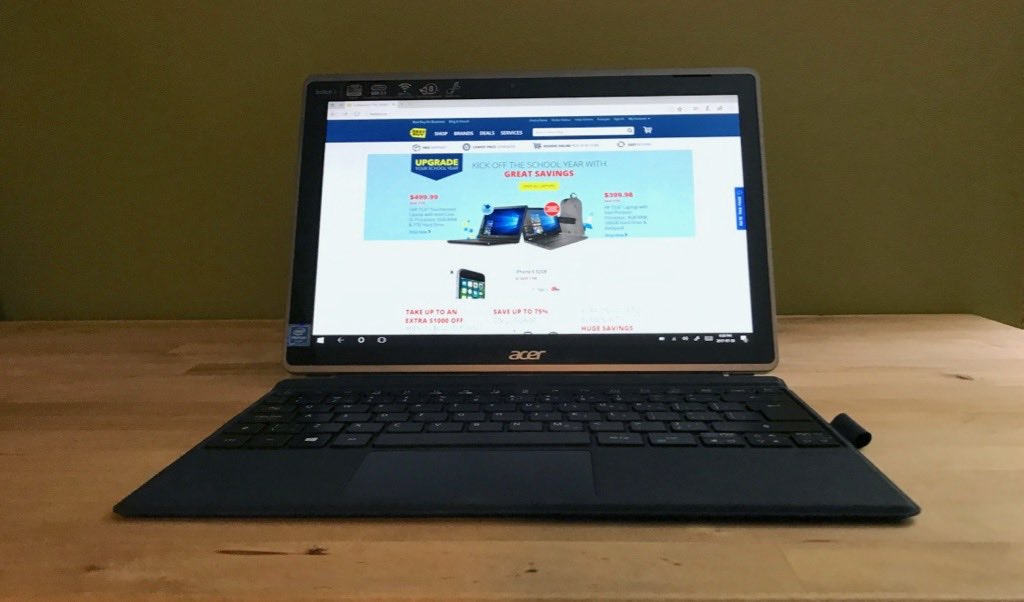
Tablets and 2-in-1 laptops are a hot back to school category. Don’t believe me? Check out Plug-in’s Ted Kritsonis’ feature on the ultra flexible mobile computing devices. And if you read Ted’s post you’ll find the Acer Switch 3 gets the nod as a budget-friendly option. I spent the past week or so testing a Switch 3, and I’m going to expand on just why it deserves a spot on your back-to-school short list.
Unboxing and Setup: Keeping it Simple (With a Little Help from Cortana)
The Acer Switch 3 arrives in a small box that give you a pretty good indication of how compact it’s going to be. Inside is a small USB adapter, which a nice change from the power bricks with some laptops, although it would have been nice for the prongs to fold to make it even easier to store. The good news is it connects to a power port, not the Switch 3’s USB-C port, so that connectivity option remains available even when plugged in.
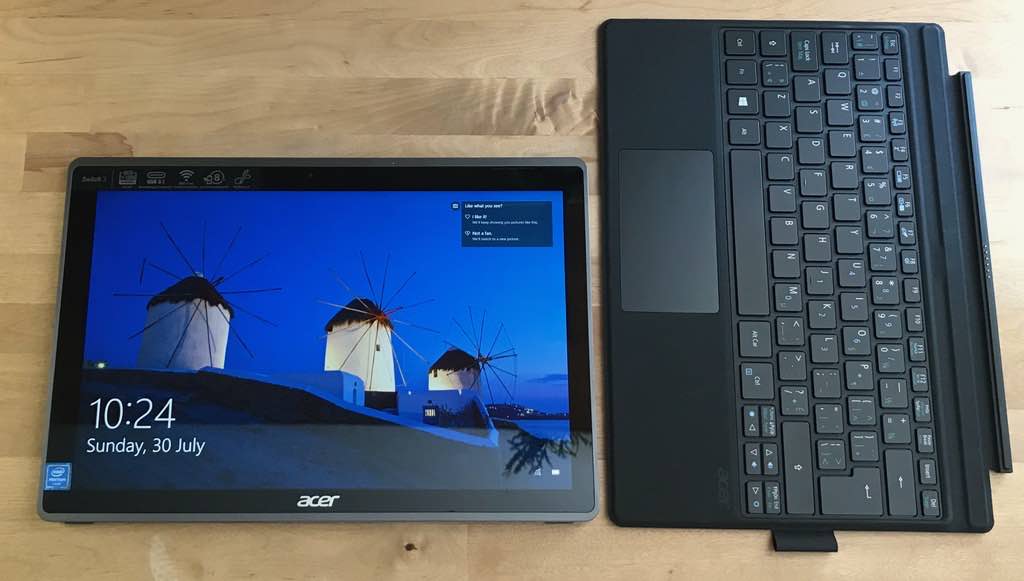
Also in the box is the tablet itself—obviously. It measures 20.1 x 29.49 x 1.63 cm and weighs 1.3 kg. That’s not bad for a tablet with a 12.2-inch display.
Beneath the tablet is a keyboard cover. This is a big win, especially in a budget-priced 2-in-1 laptop. Without that cover the device is a tablet. A tablet with a useful kickstand, but purely tablet. Add the keyboard cover, and it’s a true laptop alternative, but most manufacturers sell that keyboard as an optional accessory. With the Switch 3 you get it in the box, so you have everything needed.
Setup is straightforward. It’s the usual choose a keyboard layout, connect to Wi-Fi, check for updates kind of routine. However, The Switch 3 uses Microsoft’s Cortana virtual assistant to provide verbal directions, explanations and even a bit of humour. This was the first PC I’ve set up that’s used Cortana this way and it was really effective.
Acer Switch 3 Key Specs as Tested
|
Convertibility is Key
The big value proposition of 2-in-1 laptops like the Acer Switch 3 is convertibility. In a single device, you get a tablet and you get a laptop—or at least something that’s close to the true laptop experience and for most people, should be able to replace a laptop. As I mentioned earlier, the Switch 3 does a better job out the box than many 2-in-1s because Acer actually includes the keyboard case.
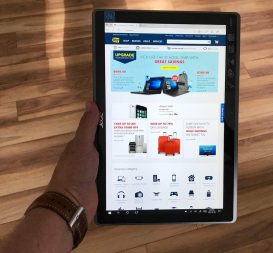
As a tablet, it’s large. If you’re used to an iPad, this is much larger than anything but the biggest iPad Pro. Think Microsoft Surface Pro and that’s the size. But the 12.2-inch display makes for an enjoyable reading and web browsing experience. It’s fairly light for the size and the integrated stand actually sticks out a few millimetres when folded, providing a nice grip for holding the Switch 3 when in tablet mode. I don’t know if that was by design or an accident, but it worked well for me. The IPS display has great viewing angles and is quite bright. Pop out that kickstand to prop the tablet upright, connect to Wi-Fi using its 802.11ac and streaming HD video looks really good.
You can also use it with a stylus for sketching and mark-up with Windows 10’s new Windows Ink feature.
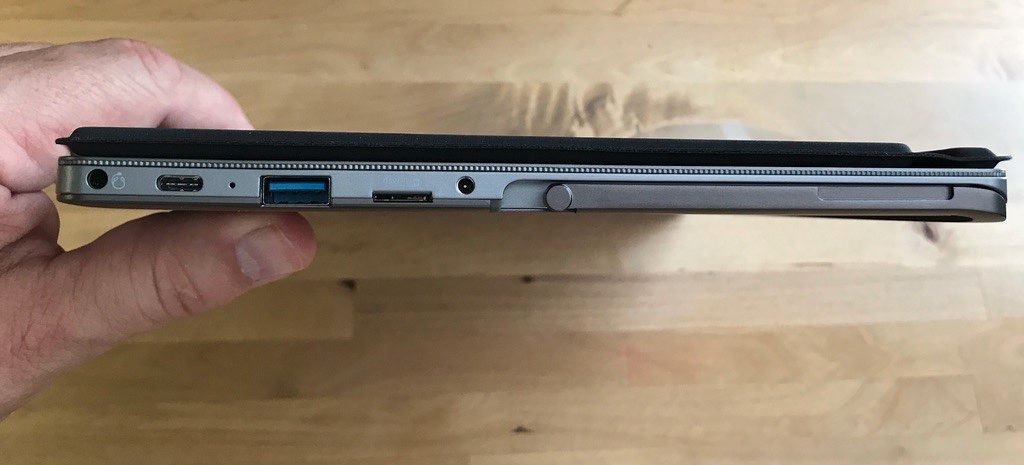
The keyboard case snaps on magnetically and stays solidly connected. It’s a full-sized, chiclet style that makes for a decent typing experience. It sits almost flat, but the end connected to the tablet is raised slightly and that can create a little bounce if you hit the keys hard—which I tend to do, as I use a mechanical keyboard as my primary input. You can adjust the kickstand angle up to 165-degrees, so it’s easy to get the perfect view.
With the kickstand and keyboard you get a laptop experience, but it’s best to keep it off your lap itself and stick to flat surfaces. In terms of battery life, 8 hours—or “all day”—is achievable, but not if you’re streaming HD video with the brightness and volume cranked up …
Performance of the Acer Switch 3
While the display really impressed and connectivity options are generous in a tablet, performance is where the “budget” part of the equation makes itself known. The Switch 3 is powered by a quad-core Intel Pentium N4200 CPU running at 1.1GHz, with 4GB of RAM and 64GB of storage. That’s not the world’s most powerful CPU and not a ton of RAM, but it’s sufficient to run Windows 10 and fine for web browsing, running Office, streaming video and general computing.
It’s not well suited for tasks like editing video or playing games. And start opening a bunch of tabs on the web browser and the 4GB of RAM will make its presence known as responsiveness starts to suffer. 64GB is not a lot of storage, although that’s enough for thousands of essays and school assignments. And with the microSD card slot, you can easily supplement the built-in storage with a memory card.
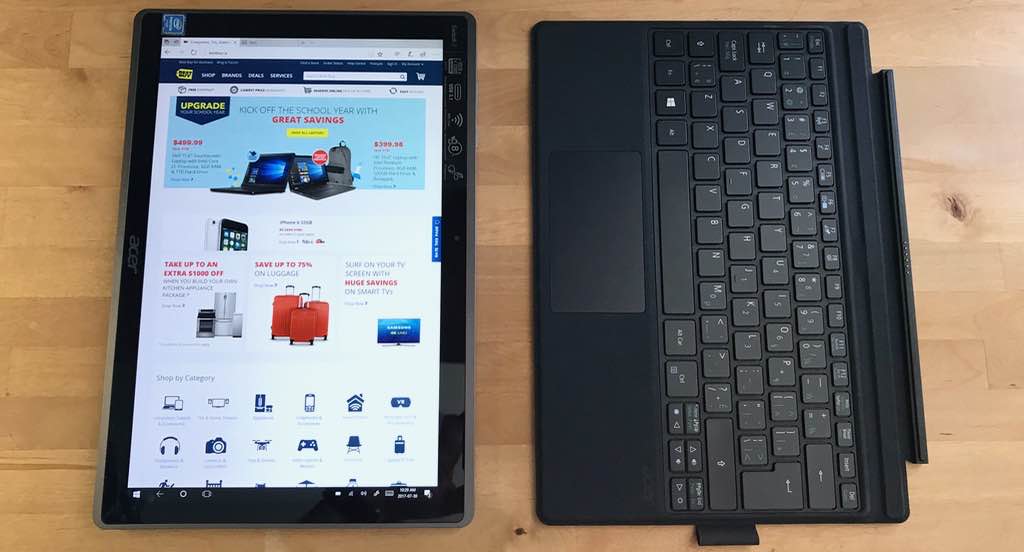
Bottom Line
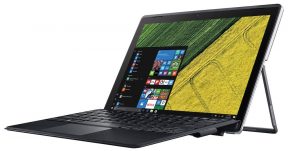 If you’re looking for a high-powered, prosumer 2-in-1 device, that would mean looking at something like a Surface Pro or iPad Pro. However, if you love the flexibility of having a tablet and laptop in a single device but want to keep the outlay low, the Acer Switch 3 is well worth considering. It has everything most students might need (other than gaming) and covers casual computing and tablet use cases. With the keyboard case included in the box, it’s a solid value.
If you’re looking for a high-powered, prosumer 2-in-1 device, that would mean looking at something like a Surface Pro or iPad Pro. However, if you love the flexibility of having a tablet and laptop in a single device but want to keep the outlay low, the Acer Switch 3 is well worth considering. It has everything most students might need (other than gaming) and covers casual computing and tablet use cases. With the keyboard case included in the box, it’s a solid value.
Looking for something a bit different, or wanting to compare the Switch 3 against other options? Make sure to check out the full selection of 2-in-1 laptops and the full range of computers at Best Buy.




“connect to Wi-Fi using its 802.11ac and streaming HD video looks really good”
Which programm have you used to stream via Wi-Fi? Did you only streamed Videos or the whole Desktop? I would like to use a Beamer with a WLAN dongle for streaming my Desktop of my Switch 3 in school. And now I’m looking for the right dongle. I would be glad, if you could give me some help for it 🙂
Hi, Christian. Streaming video was via Netflix and YouTube. Sorry, but no experience on the desktop streaming front…
I just bought a switch 3 and I’m half pleased. As a laptop in desktop mode it works great – it’s light and the touch screen is great for showing documents to others in a meeting. Where it fails is as a tablet. It won’t start as a tablet. Acer tells me there’s no way to get rid of the password or to enter the password without the keyboard. The other problem is that as a tablet, you can’t use all the neat apps available for other operating system, only the junk at the Microsoft store. You can’t even access the programs (excuse me apps) from the desktop. I would love to use the Firefox browser to look up stuff away from my desk but only the crummy Edge seems to be accessible. Also, the typewriter is hard to use in tablet mode when you have cold fingers.
So long as you have relatively modest requirements, this would work well. I wouldn’t recommend for video gaming or high demand tasks. It also cannot be upgraded –RAM and SSD can’t be added to later– but you can boost storage with SD cards. Casual computing such as web browsing, social media, video streaming and Word, it works well.
dear brad I am looking for a 2-in-1 laptop and wonder if the 12.2″ acer switch 3 would be my choice.
because it does not have an ethernet port to connect it to the internet, as i am not going to use a router
to connect to the internet.
furthermore, does it have room for expanding the storage capacity beyond 64gb?
Thank you
joe ST hamilton ont
Comments are closed.